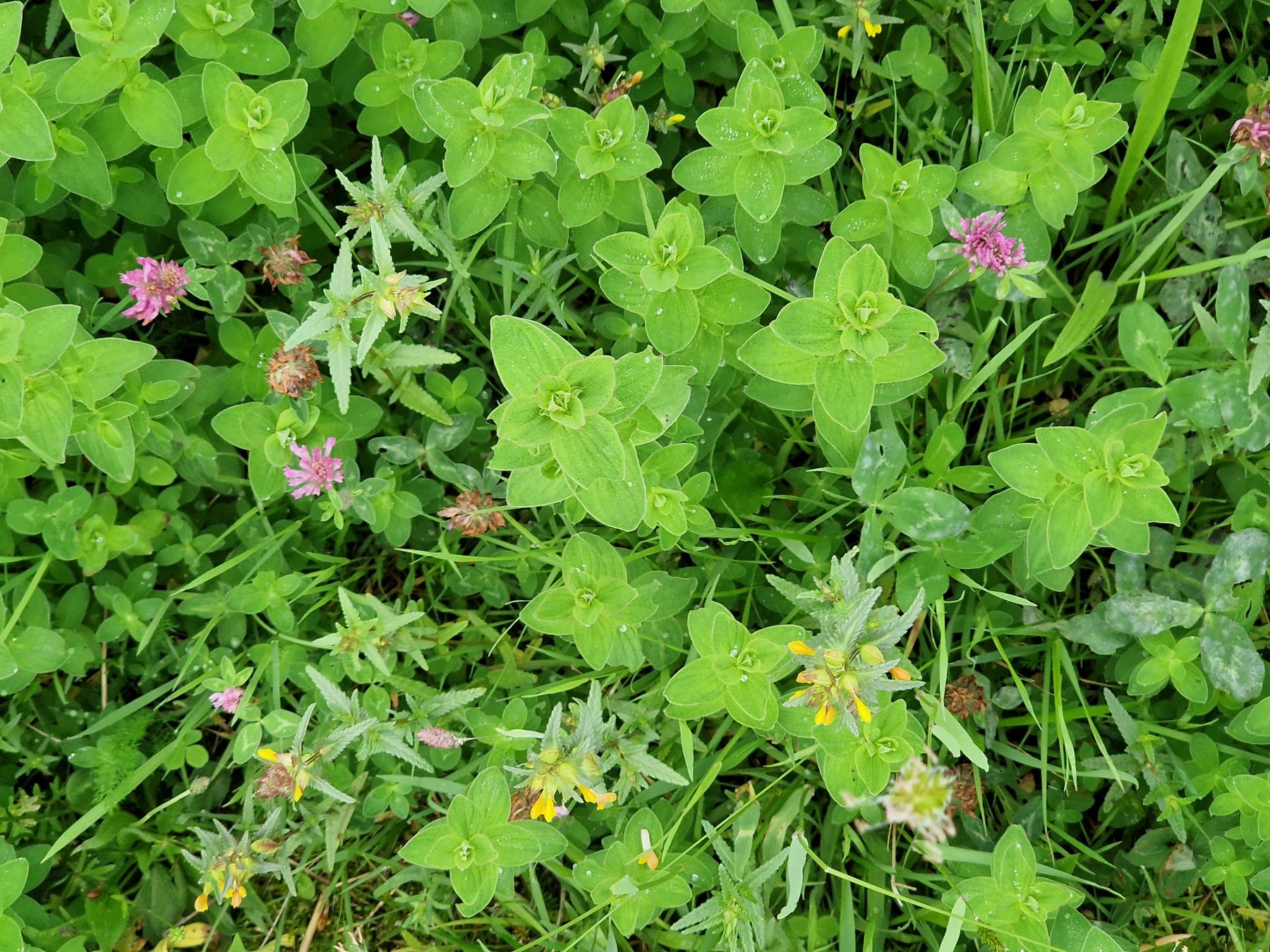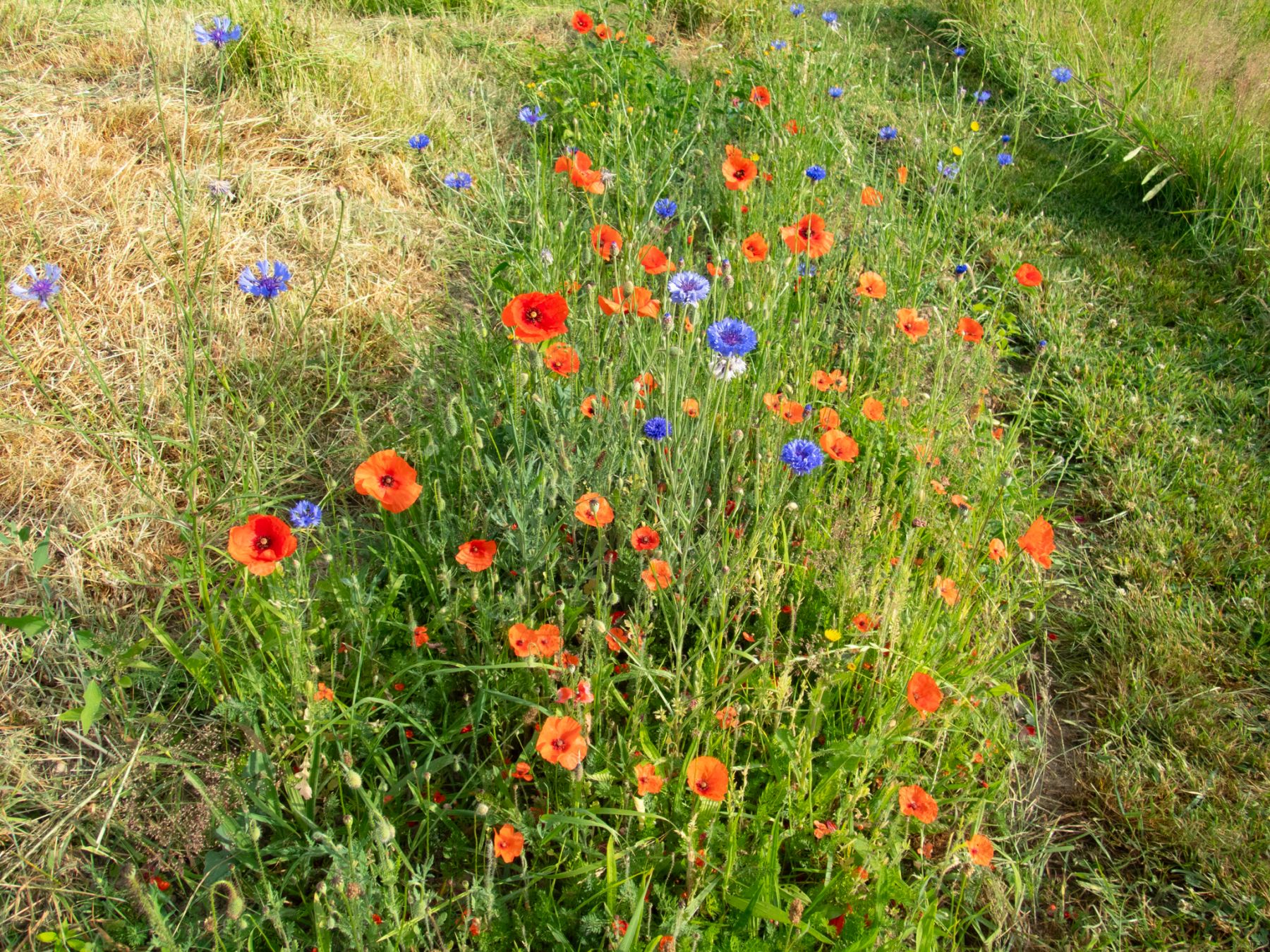

The joys of a flower meadow
26/05/2024
contact us
But ... in large areas, tufted grass was lord and master, smothering just about every flower. In second place was cat grass, a beautiful but also persistent grass. Both grasses grow tall and are known from what is called the ‘dominant grass phase’ of the meadow. The word says it all, grasses taking over... I prefer long grass to a mowed lawn, but with some flowers and colour it could be nicer.
Every spring in our garden, we look forward to seeing how our flower meadow evolves. For the most part, we let it grow long and mow grass paths within. Every year we hope for more flowers and colour. In some patches this works out fine, in others less so. Would you like a flower meadow too? Read more about our experiences of the last 3 years here.
When we moved here in the heatwave of August 2020, there was only short lawn, or rather a withered brown turf with few flowers. The first year we just let everything grow tall and observed what spontaneously emerged. That was already very hopeful: lots of daisies, knotweed, red and white clover, bush vetch, yarrow, wild carrot, creeping and tuberous buttercup, dandelion, as well as musk mallow, St John's wort, germander speedwell, creeping thistle, common hogweed, and rooted cat’s ear. The occasional field scabious made us very happy.
But ... in large areas, tufted grass was lord and master, smothering just about every flower. In second place was cat grass, a beautiful but also persistent grass. Both grasses grow tall and are known from what is called the ‘dominant grass phase’ of the meadow. The word says it all, grasses taking over... I prefer long grass to a mowed lawn, but with some flowers and colour it could be nicer.
To tease out those grasses, mow them before they drop their seeds, ideally before mid-June. We weren't on time for all grass zones that first year. Another approach is to sow in the annual semi-parasite, yellow rattle, nicely called the meadowmaker, which also helps to weaken grass dominance. This species only grows well in zones that already have some flowers, not in the pure grass zones. Every summer, we harvest their seeds and spread them on other parts. As an annual plant, this also helps to avoid losing the species in your garden. This year, after a wet period the rattle is doing very well and has been in full bloom since mid-May.
In the summer and autumn of that first year, we also collected flower seeds on our walks nearby. We sowed these in mole and ant hills. You must sow on bare soil, otherwise it won't work. This yielded us, among others, the great mullein, valerian, more and more comfrey and also cardamom. In two smaller areas, Frank removed the sods and we sowed poppy and cornflower, which gave a nice blue-red effect. In the second year, more flowers were already coming up, such as tuber stone crush, lesser clover, more roller clover, rapunzel, more field scabious, marsh thistle, and cabbage thistle... All these plants were in our garden’s seed bank waiting to flourish again. So often a lot of potential is simply already present on site.
To speed up the process a bit, we also bought seeds of native flowers and sowed them directly, others I pre-sowed in pots and then planted them out when a bit larger. This way they stand a better chance of surviving. I bought other native plants from Ecoflora in Halle and Apiflora in Solières for planting. The range of species thus expanded to include nettle-leaved bellflower, red campion, ragged robin, garden speedwell, evening primrose, and hemp agrimony and others.
Sometimes you need some patience, biennial flowers have only a leaf rosette in the first year only to flower in year 2. They are therefore often hard to spot in the first year. Many of the perennial flowers invest in their roots first and sometimes only give flowers in the third year, especially in our shallow stony soil. I thought numerous of my plantlets did not make it but it turned out they only have the energy to flower in year 3. As so often in a garden, it is a matter of a lot of patience, persistence, observation, adjustment and trial and error. Some species eventually never thrive, I keep trying the beautiful meadow sage but without success so far. Other species are much easier. Anyway, the more species the better, meaning a longer flowering period and more nectar and pollen supply for our pollinators. Read about it in our previous blog.
In addition, mowing management at the right time is important. We mow 2-3 times a year, depending on the zone. A first time before the end of June (or even as early as May if there is mostly grass or if the long grass risks falling flat) and a second time at the end of October so that the grass is short before winter. This year, we even did an extra mowing in February because the grass was already long. Hence, it is not an exact science and observation is important as the weather varies every year. ‘Flower Power The Garden’ has released a handy decision tree for flowering grassland and guides you step by step (only in Dutch sorry).
Also, never mow everything at once and leave at least 20% in place until next spring so that insects can take shelter here and complete their life cycle (hibernate), and there will still be some nectar left for the pollinators when the rest is mown short and other flower species can come into seed.
Have you just had works done around your house or have recently moved and there is a patch of bare earth. Then that is the ideal opportunity to sow a flower meadow, ideally in autumn or early spring. Grass comes naturally anyway so choose a seed mixture with many native herbs, a mix with at least 10 to 20% annuals and biennials so you will have some colour already in the first few years. The remainder should be perennial plants. To transform an existing grass area like ours, you need a bit more patience, unless you have the muscle power to cut all the grass sods.
So, it takes patience, trial and error and a combination of spontaneous growth thanks to the seed bank present, of sowing collected or bought native seeds, and of planting home-grown plants from seed or bought from the shop. And then you see what works and mow in time to decrease the grasses. We prefer native species because that's what insects favor most. Cultivars are ecologically less valuable. The exception we make are planting flower bulbs as they allow us to start the flowering season already in March. That way you get a well-balanced result. The nice thing is that it gets better every year. Be realistic, a flower meadow is subtle with accents of colour here and there, not an explosion of colours.
Also want to get started? If you would like some more advice about your specific situation, do not hesitate to contact us. Have fun with it! Biodiversity will be grateful.
Comments
- Amai wat een inzet en ˋcomittment´ chapeau daarvoor! We doen ook ons best maar dat niveau zullen we nooit bereiken. Uit jullie tips pikken we echter zeker regelmatig wat op en proberen dat ook toe te passen. Dikke Merci daarvoor . (Johan en Erika)
- La nature (et moi aussi puisque j'en fais partie ;-) vous dit merci ! (Vincent)
Add a comment


